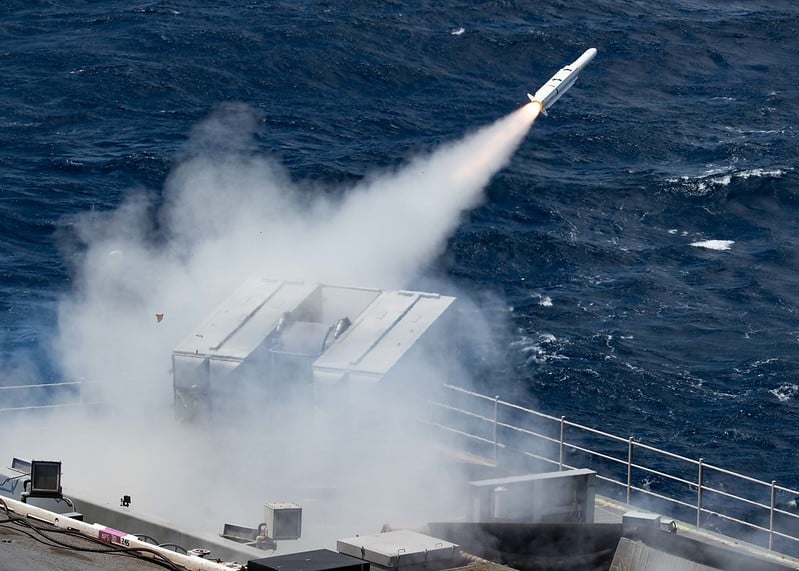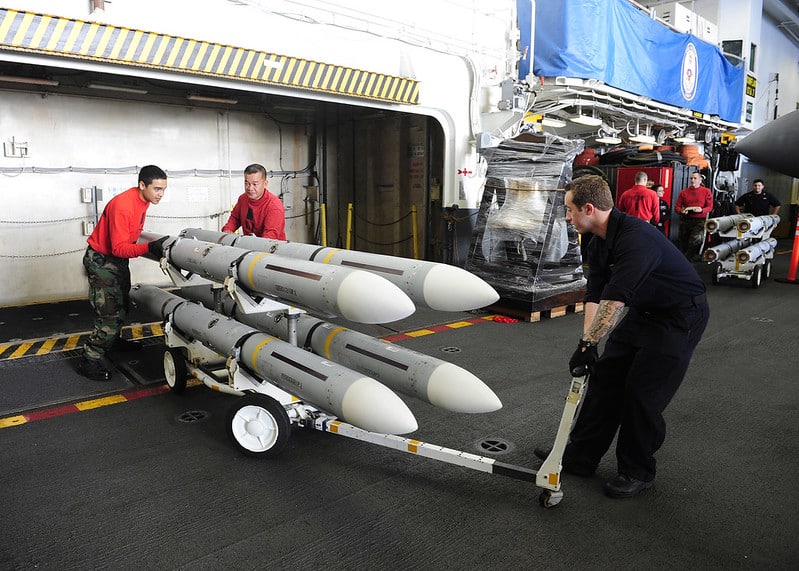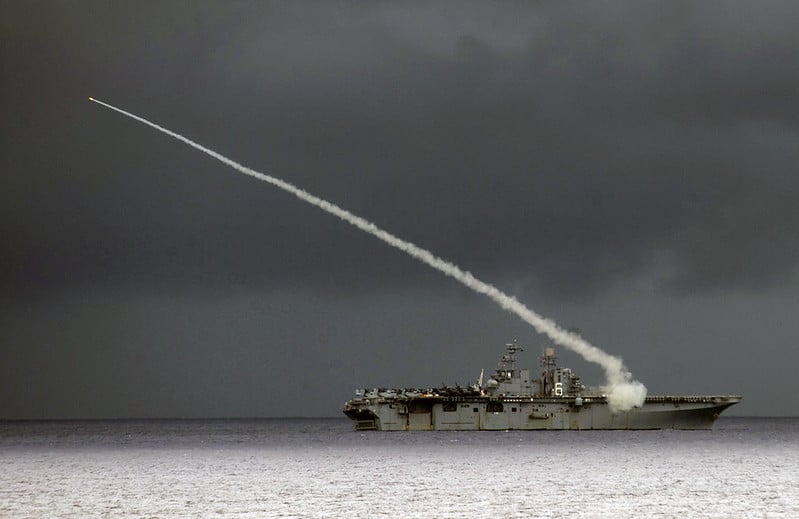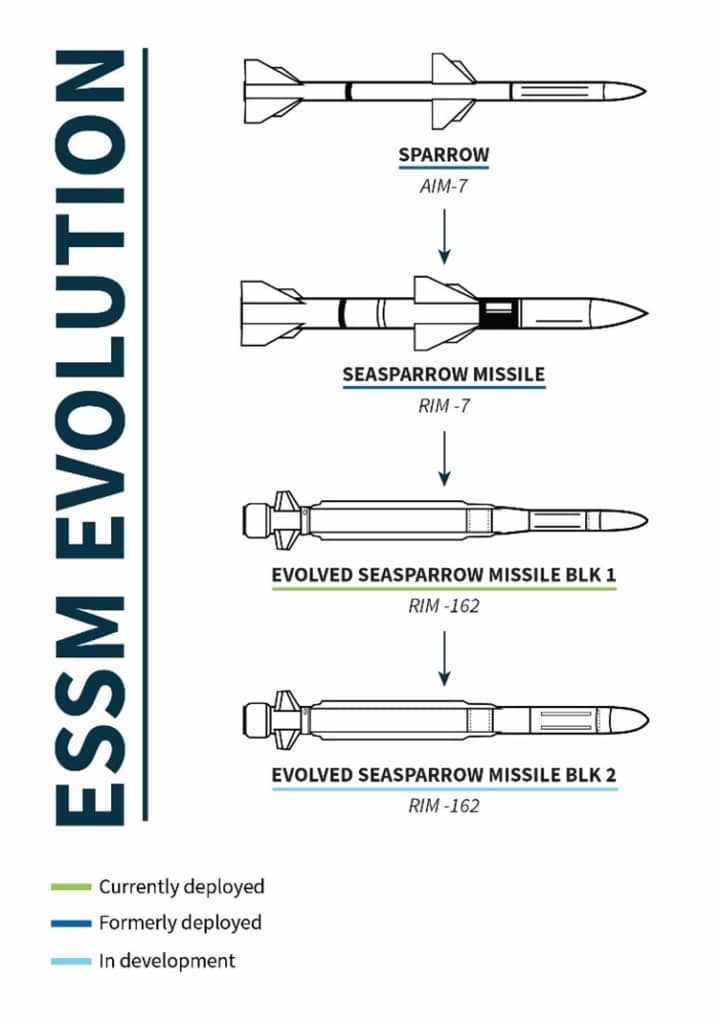The RIM-162 Evolved Seasparrow Missile (ESSM) is a medium-range, surface-to-air interceptor designed to counter high-speed antiship cruise missiles naval vessels against antiship cruise missiles (ASCM), low-velocity air threats (LVAT) such as drones and helicopters, and high-speed maneuverable surface threats.1 The ESSM works in concert with other air defense interceptors, such as Standard Missile-2 and Standard Missile-6 to provide naval vessels with a layered defense.

Evolved Seasparrow Missile (ESSM) at a Glance
- Originated From
- Australia, Canada, Denmark, Germany, Greece, Norway, Spain, Turkey, Netherlands, and the United States
- Possessed by
- Australia, Canada, Denmark, Germany, Greece, Japan, the Netherlands, Norway, Spain, Thailand, Turkey, UAE, and the United States
- Basing
- Ship-launched
- Class
- Surface-to-air missile
- Length
- 3.64 m
- Diameter
- 0.254 m
- Range
- 50 km
- Guidance
- Inertial, semi-active radar
- Propulsion
- Solid propellant
- Speed
- Mach 4
- Status
- Operational
- In Service
- 2004-Present



Evolved Seasparrow Missile Development
The advent of the high-speed jet aircraft equipped with sea-skimming, antiship missiles in the late 1950s posed a clear threat to U.S. and allied naval vessels, and exacerbated the inadequacy of the gun-based naval air defenses of the era. Today’s RIM-162 ESSM is a derivative of the RIM-7 Seasparrow missile (SSM), a sea-launched version of the AIM-7 air-to-air Sparrow missile, that was created in response the advancements of the late 1950’s. Compared to the original SSM, the ESSM upgrade introduced midcourse data uplink capabilities, an updated inertial guidance system in addition to its semi-active radar, and a redesigned warhead section. After 1987, all Seasparrow missiles were produced both slant and vertical launch capable, following successful VLS testing. In 1995, Seasparrow development began increasing the missile’s top speed to Mach 2 and enabling it to perform 30 g maneuvers.

NATO Seasparrow Consortium
Following the sinking of the Israeli destroyer INS Eilat in 1967 by a Russian antiship cruise missile, NATO allies saw an increased need for a reliable self-defense missile to protect their navies. In 1968, four countries (Denmark, Italy, Norway, and the United States) signed a memorandum of understanding (MoU) to jointly develop the NATO Seasparrow Surface Missile System (NSSMS). These countries also formed the NATO Seasparrow Consortium, which has grown to 12 countries today (see Table 1).
| Consortium Member | Year Joined |
| Denmark | 1968 |
| Norway | 1968 |
| United States | 1968 |
| Belgium | 1970 |
| Netherlands | 1970 |
| Germany | 1977 |
| Greece | 1982 |
| Canada | 1982 |
| Turkey | 1986 |
| Portugal | 1988 |
| Australia | 1990 |
| Spain | 1991 |
Membership in the consortium gives states a seat on the Project Steering Committee, allowing them to give input on the direction and management of the project. Consortium members also share the financial burden of developing new variants of the weapon system.2 Ten of the twelve Seasparrow Consortium members currently participate in the ESSM development program. These include: Australia, Canada, Denmark, Germany, Greece, Norway, Spain, Turkey, Netherlands, and the United States.3 Some non-signatories – Japan, Peru, Thailand, Saudi Arabia, South Korea, Finland, and the United Arab Emirates – have also been permitted to acquire ESSM (see Table 2).
In April 1991, the NATO Seasparrow Project Office submitted a proposal to the NATO Seasparrow Project Steering Committee to upgrade the NSSMS to improve performance against faster and more maneuverable low-altitude threats. This led to the development of the ESSMs deployed today. 4 The first round of testing for Block I began in March 2000, during which ESSM successfully destroyed a maneuvering drone target. Successful live-fire tests using uplinked commands from the Aegis AN/SPY-1 radar occurred in 2001. Operational evaluation of initial production missiles commenced in 2002. A July 2002 test from the USS Shoup (DDG 86) represented the first time an ESSM was launched from the Mk 41 VLS on an Arleigh Burke-class destroyer and the first successful use with the Aegis Baseline 6 Phase III command system.5 The U.S. Navy has officially operated the ESSM since 2004.6
Low-Rate Initial Production (LRIP) of ESSM Block I for Australia, Germany, Greece, Netherlands, Norway and Spain commenced in 2005. The first launch from an Australian Adelaide-class frigate occurred in 2007. ESSM intercepted an aerial target during Australia’s 2011 sea trials. The U.S. Navy Self-Defense Test Ship engaged a high-diving supersonic target with an ESSM in 2013.
Table 2: ESSM-equipped Ships Worldwide
| Country | Ships | Launcher |
| Australia | Meko-200, modernized Perry, Adelaide-class frigates, Hobart destroyers | Mk 41 |
| Canada | Modernized Halifax-class frigates | Mk 48 |
| Denmark | Absalon & Iver Huitfeldt frigates | Mk 56 |
| Finland | Pohjanmaa-class corvettes | Mk 41 |
| Germany | Sachsen (F-124/Type-124) frigates | Mk 29, 41 |
| Greece | Modernized Meko-200 frigates | Mk 29, 48 |
| Japan | Hyuga helicopter carries, Akizuki, Takanamim, & Murasame-class frigates | Mk 41, 48, 29 |
| Mexican | Allende frigates | Mk 25 |
| Netherlands | De Zeven Provincien frigates | Mk 48, 41 |
| New Zealand | ANZAC (Meko-200) frigates | Mk 41 |
| Norway | Nansen-class frigates | Mk 48, 41 |
| Peru | Aguirre (Lupo)-class frigates | Mk 29 |
| Portugal | Vasco de Gama-class (Meko-200) frigates | Mk 29 |
| Saudi Arabia | MMSC-class frigates | Mk 41 |
| South Korea | Nampo-class minelayer | Mk 48 |
| Spain | De Bazan F-100-class frigates | Mk 41 |
| Thailand | Chakri Naruebet-class frigates | Mk 29, 41 |
| Turkey | Gabya & Meko-200-class frigates | Mk 29, 41 |
| United Arab Emirates | Baynunah corvettes | Mk 56 |
| United States | Gerald R. Ford-class aircraft carrier, America-class amphibious assault ship, Wasp-class landing helicopter dock amphibious assault ship, Arleigh Burke & Zumwalt-class destroyer, Ticonderoga-class cruise | Mk 29, 41 |
Evolved Sea sparrow Missile Block II
Currently in development is the Evolved SeaSparrow Missile Block II (ESSM Blk 2), which is expected to feature an active guidance system that both sends and receives electromagnetic (EM) signals to improve its flight. This active guidance system will reduce ESSM’s dependence on ship-based illuminator guidance systems, such as the U.S. Navy’s SPG-62 radar. Illuminators bounce EM signals off targets to “paint” them to provide terminal guidance for the interceptor. Equipping the ESSM Blk II with its own active illuminator system will make it more capable against maneuvering threats. The ESSM Blk II will also feature a new blast fragmentation warhead.7 Australia, Canada, Denmark, the Netherlands, Norway, Turkey, and the United States are jointly acquiring Block II. 8
Evaluation of the ESSM Blk II is currently set in two phases; initial operational capability and full-rate production. The first live fire test of Phase 1 took place in July 2018 aboard USS Carl Vinson.9 Further naval testing in August 2021 highlighted several deficiencies in need of addressing prior to the final Phase 1 evaluation of Blk II’s overall operational effectiveness, suitability, and survivability.10 The Navy expects Phase 1 completion in FYY23 and full-rate production by FY25.11
Specifications
ESSM is an atmospheric, surface-to-air interceptor missile. It is 3.64 m in length and 0.254 m in diameter, with a range of around 50 km. Using solid fuel, ESSM travels at Mach 4, relying on inertial and semi-active radar for guidance. ESSM guidance systems operate in three different modes: home all the way (HAW), mid-course guidance (MCG) with terminal X-band guidance, or mid-course guidance with S-band uplinked terminal guidance. In HAW guidance mode, the missile uses semi-active homing from launch to kill. In MCG, the interceptor uses its inertial guidance system to fly to a pre-programmed point, at which time it receives a targeting update from the firing ship. MCG mode is only available when ESSM is integrated with the ACS, receiving uplinked commands from the AN/SPY-1 radar.12 In the Aegis Weapon System variant, an S-band transceiver allows for guidance from the Aegis SPY-1D S-band radar. The missile uses Thrust Vector Control (TVC) to enable tail control, allowing the missile to obtain the high speeds and maneuverability required to defend against advanced aerial threats.13
ESSM was designed to be fired from various launchers including the NSSMS Mark 29 trainable launcher, Mk 57 Vertical Launching System (VLS), Mk 41 VLS, Mk 48 Guided VLS, and the Mk 56 Dual Pack ESSM launcher.14 Additionally, ESSM can interface with all NSSMS systems, as well as the Aegis Weapons System. On Aegis-equipped ships, ESSMs are typically fired from the Mk 41 VLS, with four interceptors “quad-packed” into a single launch cell.15
ESSM can also perform in a homing on jamming (HOJ), homing on helicopter (HOH), and low-altitude guidance (LAG) modes. In HOJ mode, the missile guides on signals emitted from the target, supported by SAR. In HOH mode, the ESSM system homes on hovering, stationary targets, which have a unique radar profile. LAG mode is intended for use against low-altitude, high-speed targets such as ASCM.16
ESSM uses a solid-fueled motor with a laser ignition system. Notably, the ESSM Block I is not insensitive munitions (IM) compliant, according to NATO standards.136 IM compliant munitions are defined by NATO STANAG 4439 as munitions that “minimize the probability of inadvertent initiation and severity of subsequent collateral damage to weapon platforms, logistic systems and personnel when subjected to selected accidental and combat threats .”17
The ESSM Block II upgrade introduced midcourse data uplink capabilities, an updated inertial guidance system in addition to semi-active radar, and a redesigned warhead section.18
Service History
The ESSM was used in combat for the first time on October 9, 2016 by the U.S. Navy off the coast of Yemen. The USS Mason (DDG-87) fired two SM-2 Block IV interceptors, one ESSM, and deployed a Nulka-class antiship decoy to counter two antiship cruise missiles launched by Iranian-backed Houthi forces in Yemen. One of the Houthi missiles crashed into the sea, the cause of which is unclear. It is also unclear whether the ESSM, the second SM-2, or Nulka decoy defeated the other Houthi missile. The USS Mason was unharmed.19
Footnotes
- “Evolved SeasparrowMissile (ESSM) (RIM 162D),” Department of the Navy, last modified January 25, 2017, accessed December 7, 2018, http://www.navy.mil/navydata/fact_display.asp?cid=2200&tid=950&ct=2.
- Charles L. Roe, “The NATO Seasparrow Surface Missile System,” John’s Hopkins APL Technical Digest, vol. 12 (1991), http://www.jhuapl.edu/techdigest/views/pdfs/V12_N4_1991/V12_N4_1991_Roe_NATO.pdf.
- Ibid.
- R. Kelly Frazier, James M Hanson Jr, Michael J Leumas, Clifford L Ratliff, Olivia M Reinecke, and Charles L Roes, “Evolved Seasparrow Missile Program,” John’s Hopkins APL Technical Digest 22, no.4 (2001): 564, http://www.jhuapl.edu/techdigest/TD/td2204/Frazer.pdf.
- “ESSM Block 2 with Active Seeker Successfully Intercepts Aerial Target,” Navy Recognition, July 7, 2018, https://www.navyrecognition.com/index.php/news/defence-news/2018/july-2018-navy-naval-defense-news/6339-essm-block-2-with-active-seeker-successfully-intercepts-aerial-target.html.
- “Evolved Seasparrow Missile (ESSM) (RIM 162D),” United States Navy Fact File, http://www.navy.mil/navydata/fact_display.asp?cid=22010&tid=950&ct=2.
- “Evolved SeaSparrow Block II,” DOT&E FY2021 Annual Report, https://www.dote.osd.mil/Portals/97/pub/reports/FY2021/navy/2021essm.pdf?ver=ZAQWFqn_eoREgeBYYW2iXg%3D%3D
- Tyler Rogoway, “Watch The Navy Fire Its New Evolved SeaSparrow Block II Missile For The First Time” The Drive, November 2, 2017, http://www.thedrive.com/the-war-zone/15718/watch-the-navy-fire-its-new-evolved-sea-sparrow-block-ii-missile-for-the-first-time.
- Eckstein, Megan, “Evolved Seasparrow Missile Block 2 Successfully Intercepts Aerial Target in First Live Fire Test,” USNI News, July 6, 2018, https://news.usni.org/2018/07/06/evolved-seasparrow-missile-block-2-successfully-intercepts-aerial-target-in-first-live-fire-test.
- “Evolved SeaSparrow Block II,” DOT&E FY2021 Annual Report, DoD, January 29, 2022 https://www.dote.osd.mil/Portals/97/pub/reports/FY2021/navy/2021essm.pdf?ver=ZAQWFqn_eoREgeBYYW2iXg%3D%3D.
- “Evolved SeaSparrow Block II,” DOT&E FY2022 Annual Report, DoD, January 11, 2023, https://www.dote.osd.mil/Portals/97/pub/reports/FY2022/FY22DOTEAnnualReport.pdf .
- David Ewing and Malcolm Fuller, IHS Jane’s Weapons: Naval 2016-2017 (2016), 160.
- United States Navy Fact File.
- Ibid.
- Frazier et al., 66.
- David Ewing and Malcolm Fuller, IHS Jane’s Weapons: Naval 2016-2017 (2016), 160.
- “Guidance on the Assessment and Development of Insensitive Munitions (MURAT),” North Atlantic Treaty Organization, Report, May 31, 2006, accessed December 7, 2018, http://www.dtic.mil/dtic/tr/fulltext/u2/a522084.pdf.
- David Ewing and Malcolm Fuller, IHS Jane’s Weapons: Naval 2016-2017 (2016), 153-55.
- Sam LaGrone, “USS Mason fires 3 missiles to defend from Yemen Cruise Missiles Attack,” USNI News, Oct 11, 2016, https://news.usni.org/2016/10/11/uss-mason-fired-3-missiles-to-defend-from-yemen-cruise-missiles-attack.